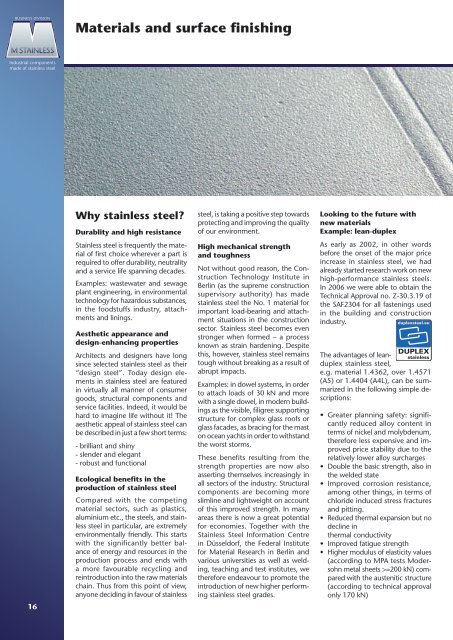The Stainless Steel Experts - MSTAINLESS
The Stainless Steel Experts - MSTAINLESS
The Stainless Steel Experts - MSTAINLESS
Create successful ePaper yourself
Turn your PDF publications into a flip-book with our unique Google optimized e-Paper software.
BUSINESS DIVISION<br />
Industrial components<br />
made of stainless steel<br />
16<br />
Materials and surface finishing<br />
Why stainless steel?<br />
Durablity and high resistance<br />
<strong>Stainless</strong> steel is frequently the material<br />
of first choice wherever a part is<br />
required to offer durability, neutrality<br />
and a service life spanning decades.<br />
Examples: wastewater and sewage<br />
plant engineering, in environmental<br />
technology for hazardous substances,<br />
in the foodstuffs industry, attachments<br />
and linings.<br />
Aesthetic appearance and<br />
design-enhancing properties<br />
Architects and designers have long<br />
since selected stainless steel as their<br />
“design steel”. Today design elements<br />
in stainless steel are featured<br />
in virtually all manner of consumer<br />
goods, structural components and<br />
service facilities. Indeed, it would be<br />
hard to imagine life without it! <strong>The</strong><br />
aesthetic appeal of stainless steel can<br />
be described in just a few short terms:<br />
- brilliant and shiny<br />
- slender and elegant<br />
- robust and functional<br />
Ecological benefits in the<br />
production of stainless steel<br />
Compared with the competing<br />
material sectors, such as plastics,<br />
aluminium etc., the steels, and stainless<br />
steel in particular, are extremely<br />
environmentally friendly. This starts<br />
with the significantly better balance<br />
of energy and resources in the<br />
production process and ends with<br />
a more favourable recycling and<br />
reintroduction into the raw materials<br />
chain. Thus from this point of view,<br />
anyone deciding in favour of stainless<br />
steel, is taking a positive step towards<br />
protecting and improving the quality<br />
of our environment.<br />
High mechanical strength<br />
and toughness<br />
Not without good reason, the Construction<br />
Technology Institute in<br />
Berlin (as the supreme construction<br />
supervisory authority) has made<br />
stainless steel the No. 1 material for<br />
important load-bearing and attachment<br />
situations in the construction<br />
sector. <strong>Stainless</strong> steel becomes even<br />
stronger when formed – a process<br />
known as strain hardening. Despite<br />
this, however, stainless steel remains<br />
tough without breaking as a result of<br />
abrupt impacts.<br />
Examples: in dowel systems, in order<br />
to attach loads of 30 kN and more<br />
with a single dowel, in modern buildings<br />
as the visible, filigree supporting<br />
structure for complex glass roofs or<br />
glass facades, as bracing for the mast<br />
on ocean yachts in order to withstand<br />
the worst storms.<br />
<strong>The</strong>se benefits resulting from the<br />
strength properties are now also<br />
asserting themselves increasingly in<br />
all sectors of the industry. Structural<br />
components are becoming more<br />
slimline and lightweight on account<br />
of this improved strength. In many<br />
areas there is now a great potential<br />
for economies. Together with the<br />
<strong>Stainless</strong> <strong>Steel</strong> Information Centre<br />
in Düsseldorf, the Federal Institute<br />
for Material Research in Berlin and<br />
various universities as well as welding,<br />
teaching and test institutes, we<br />
therefore endeavour to promote the<br />
introduction of new higher performing<br />
stainless steel grades.<br />
Looking to the future with<br />
new materials<br />
Example: lean-duplex<br />
As early as 2002, in other words<br />
before the onset of the major price<br />
increase in stainless steel, we had<br />
already started research work on new<br />
high-performance stainless steels.<br />
In 2006 we were able to obtain the<br />
Technical Approval no. Z-30.3.19 of<br />
the SAF2304 for all fastenings used<br />
in the building and construction<br />
industry.<br />
<strong>The</strong> advantages of leanduplex<br />
stainless steel,<br />
e.g. material 1.4362, over 1.4571<br />
(A5) or 1.4404 (A4L), can be summarized<br />
in the following simple descriptions:<br />
• Greater planning safety: significantly<br />
reduced alloy content in<br />
terms of nickel and molybdenum,<br />
therefore less expensive and improved<br />
price stability due to the<br />
relatively lower alloy surcharges<br />
• Double the basic strength, also in<br />
the welded state<br />
• Improved corrosion resistance,<br />
among other things, in terms of<br />
chloride induced stress fractures<br />
and pitting.<br />
• Reduced thermal expansion but no<br />
decline in<br />
thermal conductivity<br />
• Improved fatigue strength<br />
• Higher modulus of elasticity values<br />
(according to MPA tests Modersohn<br />
metal sheets >=200 kN) compared<br />
with the austenitic structure<br />
(according to technical approval<br />
only 170 kN)


